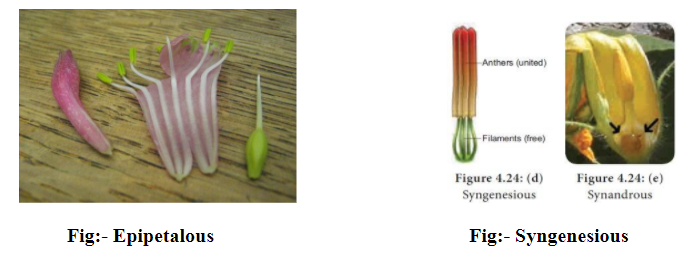
Epipetalous and syngenesious stamens occur in
a.Solanaceae
b.Brassicaceae
c.Fabaceae
d.Asteraceae
Answer
573k+ views
Hint:Epipetalous and Syngenesious stamens occur in family Asteraceae. This family possesses free filaments and fused anther.
Complete answer:
The union of stamens with other members i.e., perianth, petal or gynoecium is known as adhesion. Epipetalous is a condition in which the stamens are inserted on the corolla i.e, a flower having stamens attached to the petal.
The union of stamens among themselves is known as cohesion. Syngenesious is a condition in which the antlers are united in a bundle, but the filaments remain free.
>In the case of Solanaceae family: The no. of stamens 5, epipetalous i.e, and the stamens are attached with petals. But the anthers are not united in a bundle, it remains free.so, here syngenesious condition is not found.
>In case of Brassicaceae: The no. Of stamens 6, of which outer 2 short and inner 4 long i.e., tetradynamous (2+4). Stamens are not inserted on corolla. So, epipetalous condition is absent in this family and the anthers and filaments are also free. So, syngenesious conditions are also absent in the Brassicaceae family.
>In case of Fabaceae: The no. of stamens 10 or many. Stamens are not inserted on corolla. So, epipetalous condition is absent and others are not united together. Hence, epipetalous and syngenesious both conditions are absent.
>In case of Asteraceae: In this family the stamens are inserted on corolla, so epipetalous condition is found here. And anthers are united together to form a tube like structure but the filaments remain free. So, syngenesious conditions are also present.
These two types of conditions are found in the family Asteraceae.

Notes: Asteraceae or Compositae is a very large and widespread family of flowering plants. It is also known as the sunflower family. These two types of conditions are found in the family Asteraceae but only epipetalous stamens are found in Solanaceae family.
Complete answer:
The union of stamens with other members i.e., perianth, petal or gynoecium is known as adhesion. Epipetalous is a condition in which the stamens are inserted on the corolla i.e, a flower having stamens attached to the petal.
The union of stamens among themselves is known as cohesion. Syngenesious is a condition in which the antlers are united in a bundle, but the filaments remain free.
>In the case of Solanaceae family: The no. of stamens 5, epipetalous i.e, and the stamens are attached with petals. But the anthers are not united in a bundle, it remains free.so, here syngenesious condition is not found.
>In case of Brassicaceae: The no. Of stamens 6, of which outer 2 short and inner 4 long i.e., tetradynamous (2+4). Stamens are not inserted on corolla. So, epipetalous condition is absent in this family and the anthers and filaments are also free. So, syngenesious conditions are also absent in the Brassicaceae family.
>In case of Fabaceae: The no. of stamens 10 or many. Stamens are not inserted on corolla. So, epipetalous condition is absent and others are not united together. Hence, epipetalous and syngenesious both conditions are absent.
>In case of Asteraceae: In this family the stamens are inserted on corolla, so epipetalous condition is found here. And anthers are united together to form a tube like structure but the filaments remain free. So, syngenesious conditions are also present.
These two types of conditions are found in the family Asteraceae.

Notes: Asteraceae or Compositae is a very large and widespread family of flowering plants. It is also known as the sunflower family. These two types of conditions are found in the family Asteraceae but only epipetalous stamens are found in Solanaceae family.
Recently Updated Pages
Master Class 11 Economics: Engaging Questions & Answers for Success

Master Class 11 English: Engaging Questions & Answers for Success

Master Class 11 Social Science: Engaging Questions & Answers for Success

Master Class 11 Biology: Engaging Questions & Answers for Success

Class 11 Question and Answer - Your Ultimate Solutions Guide

Master Class 11 Business Studies: Engaging Questions & Answers for Success

Trending doubts
What is meant by exothermic and endothermic reactions class 11 chemistry CBSE

10 examples of friction in our daily life

One Metric ton is equal to kg A 10000 B 1000 C 100 class 11 physics CBSE

Difference Between Prokaryotic Cells and Eukaryotic Cells

What are Quantum numbers Explain the quantum number class 11 chemistry CBSE

1 Quintal is equal to a 110 kg b 10 kg c 100kg d 1000 class 11 physics CBSE




